5 Dropshipping Mistakes With Product Selection
When it comes to dropshipping, one of the most common dropshipping mistakes is choosing the wrong product to sell, which can be an extremely costly error for business. In this video, we’ll share with you five products you should never sell, explain why, and provide you with their alternatives.
Video transcript: I’m going to share five products that you absolutely should not sell if you’re new to dropshipping. I’ve seen many beginner dropshippers make these dropshipping mistakes and try to sell these products and it’s cost them revenue, customer trust and the sustainable growth of their business.
I’ll share exactly what those products are, but I won’t stop there. For every product on this list, I’m going to offer an alternative product to sell that will save you time and make you money. By the end, you’ll know what dropshipping mistakes to avoid, products to sell, to reduce returns, avoid trademark issues and avoid getting banned on Facebook. Ready to get started? Let’s go.
Hey everyone. It’s Jessica from Oberlo. Dropshipping is one of the easiest ways to start an online business. You can browse the thousands of products on Oberlo and sell them in your own Shopify store.
But what products should you choose, which ones should you avoid, and what are some of the biggest dropshipping mistakes when choosing products?
That’s one of many questions that come up for new dropshippers. And here at Oberlo, our job is to help you find the answers. Check out our content so you don’t miss future content about dropshipping mistakes, products to sell, Facebook marketing tactics and more.
All right, let’s get to the list. After consulting dropshipping experts and helping countless merchants, I’ve put together five types of products you should not sell if you’re new to dropshipping. I’ve seen the problems they’ve caused first-hand and I’m here to help you avoid these common dropshipping mistakes.




1. Sell Leggings Instead of Tight Jeans
The first dropshipping mistake and product you should avoid selling is tight jeans. If you’ve ever had to return clothes because of the sizing or fit, this first product won’t surprise you. The rise of online shopping has also meant the rise of clothes that don’t fit once they arrive. For your business, that means more potential returns and refunds.
The first issue you’ll run into with tight jeans is the difference between US and European sizes and Chinese sizes. Pants sizes vary from store to store, even within the same mall. So it’s no wonder that sizes from your Chinese supplier will vary as well.
→ Click Here to Launch Your Online Business with Shopify
Typically, Chinese sizes run one to two sizes smaller than US sizes.
If your customer in the United States normally wears a medium, they’ll have to order a size up. Although you can include a size chart on the product page, most customers will still instinctively order the same size they always wear.
Including a disclaimer to order one or two sizes up can cause confusion and doesn’t make for the best customer experience. If your customers end up ordering jeans in the wrong size, be prepared for potential returns and refunds.
The second issue you’ll run into at this product is that customers are just playing picky about how they’re jeans fit. Even if they do order the right size, it’s not uncommon for customers to complain that the jeans don’t flatter their figures as expected.
That’s why this product is so tricky to sell. Even if you’re clear about size differences, there’s a high potential for returns. So what do you sell instead?
Well, consider selling leggings or pants that stretch. You’ll still want to include a size chart. But the stretch will help ensure a good fit.
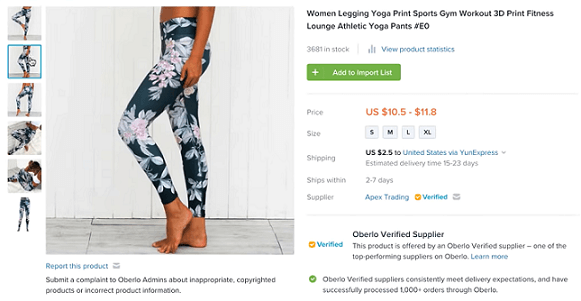
Loose or stretchy pants are easier for your customers to buy. Customers will feel more confident ordering a medium knowing that there’s some stretch in the material. For you, the business owner, this means fewer returns.
2. Sell Unbranded Shoes Instead of Trademarked Sneakers
Okay, let’s move on to the second product new dropshippers should not sell. The next product to avoid selling is trademarked sneakers.
If you don’t have a reseller license, then you cannot legally sell trademark sneakers.
This is a very common pitfall that I’ve seen new merchants fall into. They spend hours on their store and after they open their business, it gets closed down.
Why? They didn’t have a reseller license. If you don’t have a license to sell trademark sneakers, your store and your hard work will be for nothing. It’s tempting for new dropshippers to sell trademark sneakers because they do sell really well. After all, they have a recognizable brand that customers know.
However, it’s not worth the risk. Dropshippers cannot build a sustainable business around trademark sneakers. Sooner or later, their store gets shut down. And you’d be surprised how quickly merchants can get caught.
So here’s what to sell instead. Sell shoes that are unbranded or are branded with the supplier’s own brand. Many suppliers have their own in-house branding that is not trademarked.
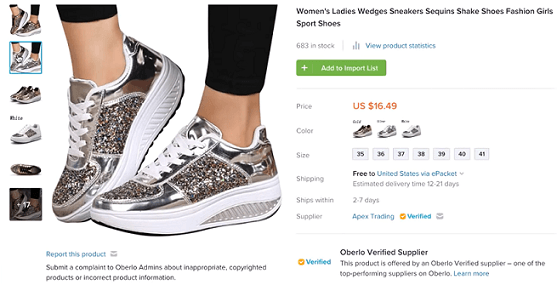
You can sell these shoes without any issues. There are thousands of high-quality shoes to sell that are trademark free. They’re trendy and they take inspiration from popular models so that you can be confident they will sell well. Not only will this help you avoid trademark issues, but it will allow you to build your business in the long run. All right, let’s move on.
3. Sell Unique Bags Instead of Standard Black Bags
Have you ever browsed products online only to find that same product in a local department store? If so, you probably bought it there in the store instead of waiting for shipping, right? That’s why you shouldn’t sell this next product. It’s black bags.
You might be asking yourself, “What’s wrong with a simple black bag?” And that’s your answer, it’s too simple. Whatever you sell, you want your customers to feel like they should purchase that product right away. Successful dropshippers have a strong understanding of how to get their customers to impulse buy.
If you run Facebook ads for a product that’s too plain, you’ll see very low conversions. The same is true if you try selling a product that customers can find in their local mall.
Here’s a better bag to sell. Products like this geometry bag will immediately grab the attention of someone’s scrolling through their Facebook news feed.
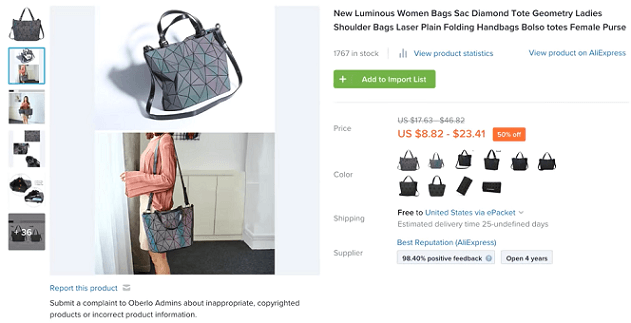
It’s colorful, unusual and makes for a good video ad. Customers will be far more inclined to click on the ad to learn more about it.
And here’s a Facebook hack to help you figure out your product is catching your audience’s attention. In Facebook Business Manager, you can see the click-through rate of your ad. That’s the number of people that saw your ad and clicked on it. If the number is below two percent, that’s a sign that you need to do more testing. You can either advertise different products or try other formats for your ad, like video.
4. Sell Furniture Accessories Instead of Furniture
Okay, the next product is one that is a result of a new trend in dropshipping. Some dropshippers are trying to sell just a few expensive products rather than many inexpensive products. But I would caution you against this because of this next product. It’s furniture.
Although you can sell furniture at a high mark-up, furniture is almost guaranteed to cause you a lot of hassles. Selling furniture violates one of the most important rules for new dropshippers.
You should never dropship a product you can’t ship with ePacket shipping.
EPacket shipping is a shipping method from China that is cheap and fast. EPacket shipping is so fast because it has a size restriction. To be eligible for ePacket, a product must be 90 by 60 centimeters and less than two kilos. Don’t worry. Most products meet these constraints.
But furniture is outside the size and weight restriction. That means you’ll need to select another shipping method and other shipping methods will cost much more, sometimes even more than the product itself and they may take longer than ePacket. That’s not a good experience for you or your customer.
At the same time, home decor is a very profitable niche. So if you want to stay in this niche, here’s what you should sell instead.
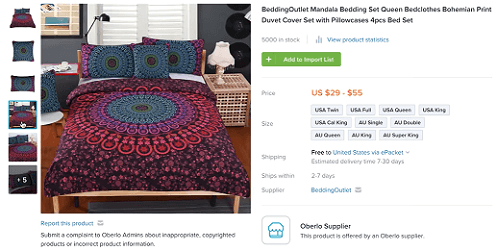
Consider selling bedding sets or any products that can be used as accessories to large furniture items. Think throw pillows for sofas, table cloth for dining room tables and so on. These products are in the home decor niche, but they’re small enough to ship with ePacket.
5. Sell Makeup Mirrors Instead of Face Masks
Confession time, I sold this next product. The one I’m about to tell you not to sell. Let me give you some context. For dropshippers, Facebook advertising is the standard for paid marketing. After setting up your store, most dropshipping guides will tell you to advertise your products on Facebook.
But before you do, it’s important to double-check that you can advertise your products.
Facebook is very strict about the types of products you can advertise. You cannot advertise anything that is smoking-related, resembles a weapon or makes any health claims.
For other restrictions, check out our Q&A video.
If you plan to advertise on Facebook, read the advertising policy before you spend time building your store. I didn’t and that’s why I got a warning from Facebook for selling face masks. Why? Well, if you read Facebook’s advertising policy closely, you’ll see that you’re not allowed to advertise products that make health claims. That’s a challenging role to deal with because health claims are so broad.
To put it simply, none of the products we advertise on Facebook can claim they change someone’s state of health.
For example, saying that a face mask brightens skin is claiming that the mask can change one state of health. Is that a stretch? Maybe.
But to take advantage of Facebook’s massive audience, you need to play by their rules. If you sell something and claim it will improve someone’s health, your ad will be disproved and your account could be banned. It’s serious.
After seeing such dropshipping mistakes made by many beginner dropshippers, I have an ad-approved alternative. It’s this beautiful makeup mirror.
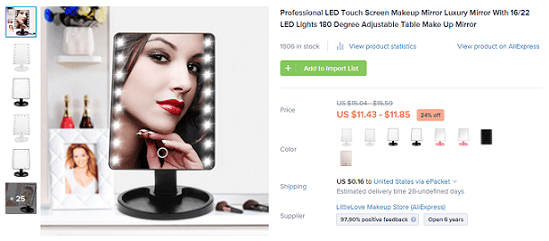
Sell this and you’ll be able to target the same wellness obsessed audience, but you won’t have any worries when it comes to advertising on Facebook. Not only is this mirror Facebook-friendly, but you can also rest assured that your customers won’t have any allergies to it.
If you found a winning product that cannot be advertised on Facebook, don’t worry, find an accessory or related product in the same niche and then advertise that accessory on Facebook to drive traffic to your ecommerce store.
From there, customers can choose if they want to buy the vanity mirror for example or perhaps they’ll discover those face masks. This way, you don’t have to redo your store or brand strategy and you won’t get banned on Facebook.
Over to you, what dropshipping mistakes have you made with your products, what products would you never ever dropship, and why? Make sure to leave a comment below so we can learn from you. And until next time, learn often, market better and sell more.



